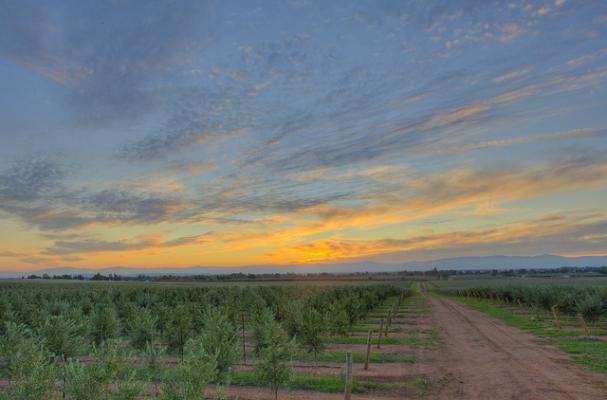
Normally when you talk about olive oil, thoughts immediately go to an idyllic Italian setting, full of green freshness and rolling hills. But a recent tasting highlighting California olive oil from California Olive Ranch showed that there is some very fresh, lively, delicious high-quality olive oil being produced closer to home.
I attended a dinner (a media event sponsored by California Olive Ranch) that was eye-opening and informative, thanks to the presence of VP of Orchard Operations Adam Englehardt. Adam is a guy who is mildly obsessed (in a good way) with getting the freshest, most flavorful olive oil to your table. And, as far as an industry goes, he's got his work cut out for him. Though the United States is the second largest market for olive oil, we produce less than two percent of what we consume. I guess an optimist would say there is room for growth.
 And the oil we use to cook, bake, make dressings, and employ as a finishing touch should be all about freshness and flavor. Adam revealed that he is not afraid to take a 35% crop loss for a flavor profile. This reminds me of winemakers "dropping fruit" from grape vines to make sure what remains has the most flavor. But, unlike the finest wines, Adam is adamant about machine harvesting being the best way to ensure high-quality olive oil. I was surprised to hear this, as in the world of wine, hand-harvesting is the quality mantra.
And the oil we use to cook, bake, make dressings, and employ as a finishing touch should be all about freshness and flavor. Adam revealed that he is not afraid to take a 35% crop loss for a flavor profile. This reminds me of winemakers "dropping fruit" from grape vines to make sure what remains has the most flavor. But, unlike the finest wines, Adam is adamant about machine harvesting being the best way to ensure high-quality olive oil. I was surprised to hear this, as in the world of wine, hand-harvesting is the quality mantra.
When it comes to the production of quality oil, however, the speed of moving the olives from tree to processing is key. As Adam stated, the majority of defects happen between harvest and pressing. Besides not being cost-effective, hand harvesting is much slower, meaning there is more chance for something bad to happen to these olives as they await pressing. To facilitate the machine harvesting, California Olive Ranch began planting their olive trees on trellises and in hedgerows. (A lot like a vineyard!)

So all this work in the field is well and good, but how do you know how long that bottle of oil has been languishing on a store shelf? One cool thing that California Olive Ranch does is give you the harvest date on the back label. And the "Best By" date is based on when the olives were harvested rather than the date it was bottled. Since olive oil is basically pressed fruit juice, you want it fresh. Once you've brought it home, defend your oil from its enemies! That would be oxygen, light, heat, and time. With olive oil advice apparently coming in fours, here's something to remember when it comes to tasting olive oil (via Nancy Ash of Strictly Olive Oil): swirl, sniff, slurp, swallow. Just like wine tasting, but without the fourth step. Fortunately, olive oil tasting does not impair your ability to drive a car or operate heavy machinery.

 And though we swirled, sniffed, slurped, and swallowed in wine glasses, the pros use these really cool-looking blue glasses so they are not influenced by the color of the oil while evaluating for quality. I'm no olive oil super-taster, but I did appreciate the spectrum of flavors from fruity to peppery, and how a blend of different olives can balance out flavors. This is how the California Olive Ranch makes their "Everyday" olive oil. As Adam explained, it's just like making a house wine; you change the blend to maintain a consistent profile. Here we go with the wine analogies again! I was definitely teasing them out of him with my questions and comments.
And though we swirled, sniffed, slurped, and swallowed in wine glasses, the pros use these really cool-looking blue glasses so they are not influenced by the color of the oil while evaluating for quality. I'm no olive oil super-taster, but I did appreciate the spectrum of flavors from fruity to peppery, and how a blend of different olives can balance out flavors. This is how the California Olive Ranch makes their "Everyday" olive oil. As Adam explained, it's just like making a house wine; you change the blend to maintain a consistent profile. Here we go with the wine analogies again! I was definitely teasing them out of him with my questions and comments.
In the last few weeks I have been really inspired to learn a lot more about both coffee and olive oil, and found that the cultivation, production, and appreciation of two things I enjoy greatly have a surprising amount in common with what I have come to know about wine. I'll raise a glass (of olive oil) to that.










